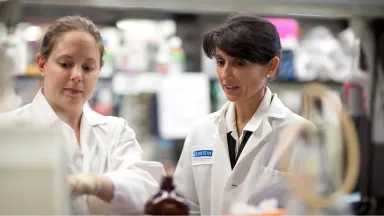
Betsy Herold, M.D.
- Professor, Department of Pediatrics (Pediatric Infectious Disease)
- Professor, Department of Microbiology & Immunology
- Professor, Department of Obstetrics & Gynecology and Women's Health
- Harold and Muriel Block Chair in Pediatrics
- Vice Chair for Research, Department of Pediatrics
- Chief, Division of Pediatric Infectious Diseases, Department of Pediatrics
- Director, Translational Prevention Research Center
Area of research
- Herpes simplex virus (HSV) infection; synergy between HSV and HIV; microbicide development; genital tract mucosal immunity
Phone
Location
- Albert Einstein College of Medicine 1225 Morris Park Avenue Van Etten 6A04A Bronx, NY 10461
Research Profiles
Professional Interests
Betsy Herold, M.D. directs a basic and translational research program, which focuses on virus host interactions. Projects in the lab include studies designed to identify the cellular signaling pathways that herpes simplex viruses (HSV) usurp to promote viral entry and infection. The lab uncovered a previously unappreciated paradigm associated with activation of phospholipid scramblases, which are known to catalyze the movement of phosphatidylserine lipids between the inner and outer leaflet of the plasma membrane. Surprisingly, they found that the exofacial movement of phospholipids is associated with concomitant translocation of intracellular proteins, including the master kinase Akt to the outside, where Akt becomes phosphorylated to activate an “outside-inside” signaling cascade that promotes viral entry. This pathway is also usurped by SARS-CoV-2 and is important for cellular processes including apoptosis. In collaboration with the Almo lab, they have engineered cell impermeable kinase inhibitors. These compounds block viral entry and prevent induction of apoptosis by select TNF ligands.
Serendipitously, in studying this signaling pathway, the lab identified a novel candidate vaccine for the prevention and treatment of HSV infections. Most efforts to develop a vaccine have focused on neutralizing antibodies that target HSV glycoprotein D (gD), but all of these have failed in clinical trials. Instead, the lab (in collaboration with the Jacobs lab), engineered a virus completely deleted in gD. Glycoprotein D is required for viral entry and cell-to-cell spread, thus the deletion virus (DgD-2) is restricted a single cycle and will not spread. This candidate vaccine elicits T cell responses and high titer, polyfunctional antibodies that protect through antibody-dependent cell mediated cytotoxicity (ADCC). The vaccine prevents the establishment of latency in mice and is significantly more protective in multiple small animal models than prior vaccines that have failed in clinical trials. The lab has subsequently isolated monoclonal antibodies (mAbs) that have this protective ADCC activity and both the vaccine and the mAbs are being advanced for preclinical development. Studies to understand why this vaccine elicits ADCC-mediating antibodies whereas gD vaccines and primary HSV infection only elicit neutralizing antibodies led to the identification of a key role for TNFRSF14 (aka HVEM) in generating and mediating ADCC responses. HVEM is an immune cell surface protein that functions in signal transduction pathways that regulate inflammatory or inhibitory immune responses but its role in shaping the B cell repertoire and in providing a second signal for ADCC had not been previously described and has implications for vaccine development and oncolytic therapies.
The third major area of basic research involves defining the molecular mechanisms underlying the HIV-HSV syndemic. Epidemiological studies have consistently demonstrated that being HSV seropositive is associated with an increased risk for HIV acquisition, replication, higher plasma viral loads and more frequent episodes of HIV reactivation. Using primary cells from patients and HIV latently infected cell lines, the lab has identified several mechanisms by which HSV promotes HIV latency reversal and replication including upregulation of the noncoding RNA, Malat1, and downregulation of IL-32. Defining these pathways may lead to identification of new strategies to “shock and kill” or “block and lock” HIV.
Clinical studies include prevention of infectious disease complications in transplantation. Members of the research group are involved in studies to optimize pre-emptive prophylaxis for CMV and EBV, vaccine responses in transplantation recipients, and others






